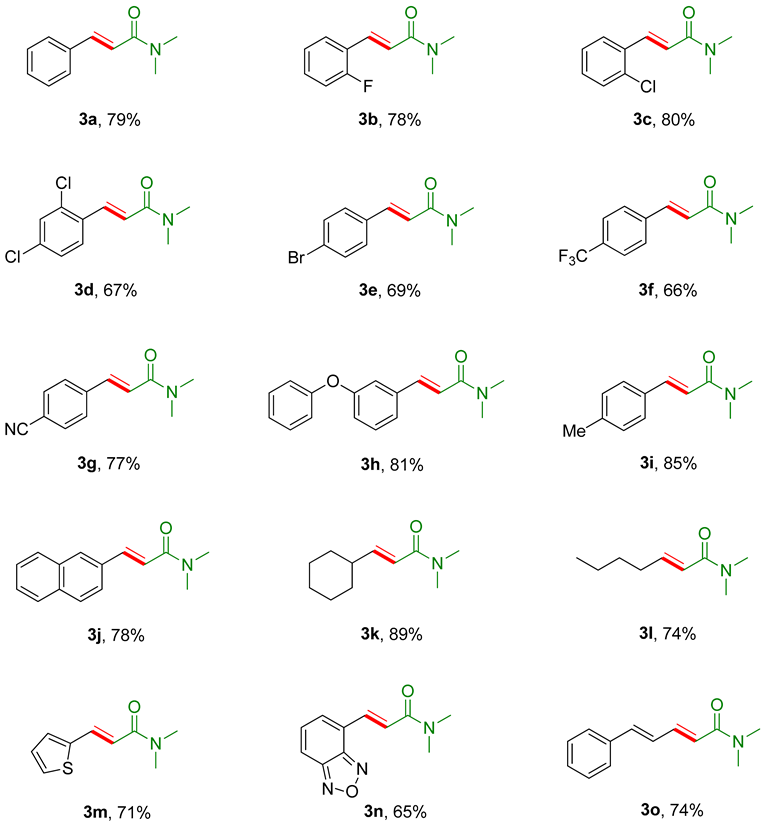Abstract
Cinnamides are common core structures that exist in a great number of pharmaceuticals and natural products. The development of efficient methods for preparing cinnamides is in great need. We report herein an efficient polyphosphoric acid (PPA)-promoted direct aldol condensation of an amide for the convenient and straightforward preparation of cinnamides. A variety of cinnamides were obtained in moderate-to-excellent yields (65–89%). This strategy features the use of equivalent amides and a short reaction time.
1. Introduction
Cinnamides have been used as building blocks for the construction of complex molecules, which commonly exist in pharmaceuticals and natural products [1,2,3,4,5,6]. Most of the cinnamides display varied bioactivities such as anti-tumor, anti-cancer, anti-depressant, and anti-convulsion effects (Figure 1) [7,8,9,10]. Very recently, Wu and co-workers reported that cinnamide derivatives exhibited neuroprotective activity and have potential for the treatment of cerebral ischemia [11,12]. Biersack and co-workers found that piperlongumine-type cinnamide derivatives showed good antiparasitic and antifungal activities [13]. Therefore, the development of efficient methods for preparing cinnamides is still a hot research topic in the field of organic chemistry. Commonly, cinnamides are synthesized from the acylation of amines with cinnamic acids [14,15,16], decarboxylative acylation of cinnamic acids [17], C-H bond functionalizations [18,19,20,21,22,23,24], and amidation of carboxylic acids [25]. However, the above-mentioned reactions suffer from limitations such as reliance on multisteps, the use of strong oxidants and special substrates, and catalyzation by transition metal or toxic metal salts.
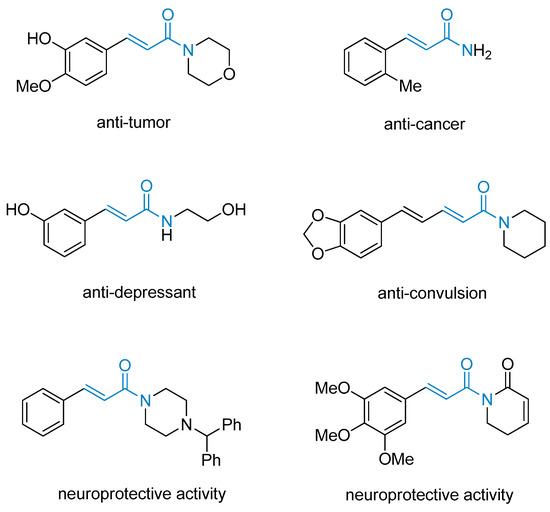
Figure 1.
Selected bioactive cinnamide derivatives.
Considering the limitations of the above approaches, the convenient preparations of cinnamides are highly desired. In 2010, the direct aldol condensation of unactivated amides catalyzed by dialkylcarbonates (DECs), as dehydrating agents, was reported (Scheme 1a) [26]. Later, Saito and co-workers reported a similar strategy for the preparation of cinnamides using 1,3,5-triazo-2,4,6-triphosphorine-2,2,4,4,6,6-hexachloride-based phosphorous (TAPC)/SO42− catalysis (Scheme 1b) [27]. Despite significant progress, the lowest acidity of the α-CH of amides results in major shortcomings such as the excessive use of dehydrating agents and amides, and the requirement of long reaction times (Scheme 1a,b). Recently, Cai and co-workers developed a visible light-promoted oxidative cross-coupling reaction of benzyl alcohols with N,N-dialkylacetamides for the construction of cinnamides; however, this strategy still needs excessive base and amides, as well as a long reaction time (Scheme 1c) [28]. Hence, the development of new synthetic strategies devoid of these disadvantages is still urgent.
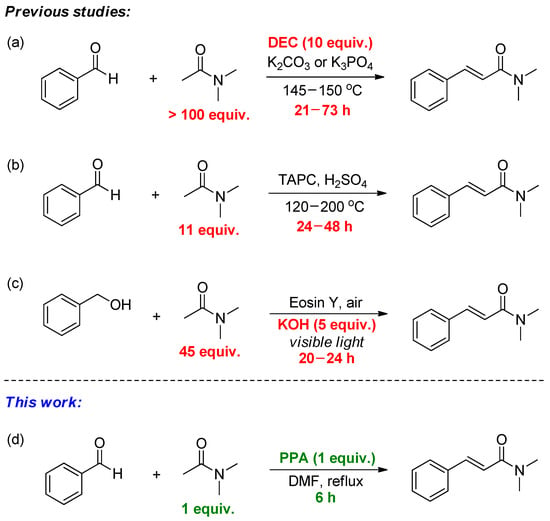
Scheme 1.
Previous reported strategies for the synthesis of cinnamides and this work. (a) Previous work: DEC-promoted aldol condensation of unactivated amides for the synthesis of cinnamides. (b) Previous work: TAPC and H2SO4 catalyzed aldol condensation of unactivated amides for the synthesis of cinnamides. (c) Visible light-promoted oxidation/condensation of benzyl alcohols with amides to cinnamides. (d) This work: PPA-promoted direct aldol condensation of unactivated amides for the convenient and straightforward synthesis of cinnamides.
The direct aldol condensation of unactivated amides is a straightforward and attractive methodology, but there is a need to develop an effective dehydrating agent to overcome the above disadvantages. PPA is commonly used as a dehydrating agent, and our group has developed several PPA-promoted condensation reactions for the synthesis of heterocycles [29,30,31]. Our previous studies indicated that PPA could activate the α-CH of the carbonyl group and efficiently promote aldol condensations. Inspired by our previous work and in continuation of our interest in PPA-promoted condensations, herein we wish to describe another direct aldol condensation of unactivated amides using PPA as an activator and dehydrating agent for the convenient and straightforward synthesis of cinnamides (Scheme 1d). This method features the use of equivalent amides and a short reaction time.
2. Results and Discussion
Initially, we set up the reaction benzaldehyde 1a and N,N-dimethylacetamide 2 as test substrates. A mixture of 1a (1 equiv.), 2 (1 equiv.), and PPA (2 equiv.) in DMF refluxed for 4 h under a nitrogen atmosphere produced the cinnamide 3a in a 46% yield (Table 1, entry 1). Screening of the amount of PPA showed that 1 equiv. was the best choice (Table 1, entries 2–4). Then, we investigated the influence of reaction temperature, and a decreased yield was observed upon decreasing the temperature to 140 °C (Table 1, entry 5 vs. 3). Subsequently, we tested the effect of the reaction time (Table 1, entries 6–8). To our delight, the reaction was found to be more effective when the reaction time increased to 6 h, which gave the desired product in a 79% yield (Table 1, entry 7). Next, we screened a serious of reaction media, such as 1,4-dioxane, THF, toluene, DCE, DMSO, and EtOH, and no improvement in the transformation was observed (Table 1, entries 9–14). Finally, the optimized reaction conditions were determined as 1a (1 equiv.), 2 (1 equiv.), and PPA (1 equiv.) in DMF refluxed for 6 h under a nitrogen atmosphere (Table 1, entry 7).

Table 1.
Optimization of reaction conditions a.
With the optimized reaction conditions in hand, we next examined the scope of aldehydes (Table 2). As shown in Table 2, the condensation proceeded well with a variety of benzaldehydes to yield desired products in moderate-to-good yields (3a–3i). Obviously, the electronic properties of the substituents had an effect on the yield. Benzaldehydes bearing electron-donating groups (OMe and Me) provided higher yields than those bearing electron-withdrawing groups, such as F, Cl, Br, CF3, and CN (3b–3g vs. 3h–3i). It was also found that this procedure was efficient for converting 2-naphthaldehyde, cyclohexanecarboxaldehyde, valeraldehyde, 2-thenaldehyde, 4-benzofurazancarboxaldehyde, and cinnamaldehyde to the corresponding cinnamides in good yields (3j–3o). Next, to demonstrate the synthetic potential of this protocol, we selected different types of aldehydes for gram-scale reactions (Scheme 2). To our delight, the gram-scale reactions also proceeded well to form the corresponding products in good yields.

Table 2.
Evaluation of substrate scope a.
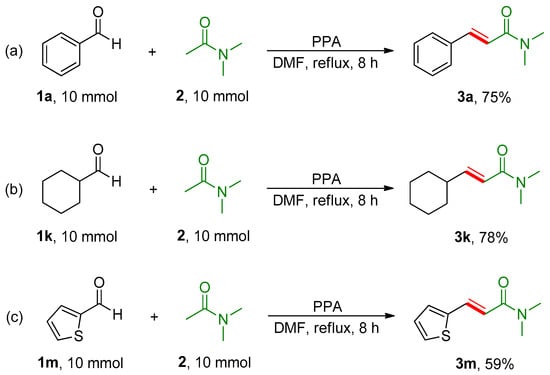
Scheme 2.
Gram-scale reactions. Gram-scale reactions of benzaldehyde 1a (a), cyclohexanecarboxaldehyde 1k (b), and 2-thenaldehyde 1m (c). Reaction conditions: PPA (10 mmol) and DMF (10 mL).
Several control experiments were conducted in order to rationalize the reaction mechanism. As shown in Scheme 3a, the reaction was carried out in the presence of different dehydrating agent/acid catalysts and the desired product 3a was obtained in a 13% yield only in the case of using concentrated sulfuric acid, which demonstrated that this reaction underwent a dehydrating process. Then, the radical inhibitor 2,2,6,6-tetramethyl-piperidine-1-oxyl (TEMPO) was employed in the reaction, yielding 3a in a high yield, suggesting that this procedure rules out the radical pathway (Scheme 3b).
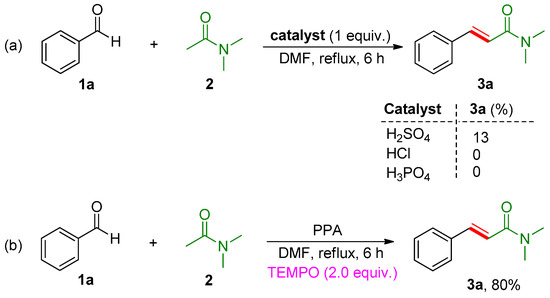
Scheme 3.
Control experiments. (a) Effect of catalyst on the reaction. (b) Investigation of free radical mechanism. Reaction conditions: 1a (1 mmol), 2 (1 mmol), PPA (1 mmol), catalyst (1 mmol), and DMF (1 mL).
Based on the mechanistic study and our previous reports [29,32], a plausible mechanism of the PPA-promoted aldol condensation of amides for the synthesis of cinnamides is depicted in Scheme 4. Firstly, amide 2 was activated through the formation of the phosphorylated adduct 4, followed by an enolization to produce intermediate 5. Then, intermediate 5 coupled with protonated benzaldehyde 1a formed intermediate 6, which was followed by a PPA-driven dehydration process to give intermediate 7. Finally, the carbocation is stabilized by removing a proton from the beta position yielding the desired product 3a.
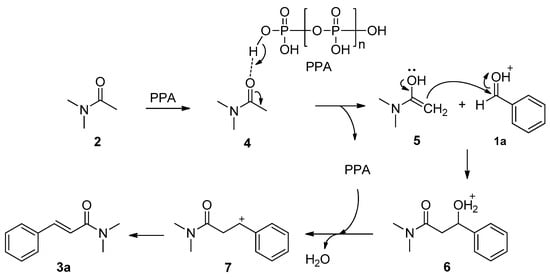
Scheme 4.
Plausible mechanism.
3. Materials and Methods
3.1. General Information
All reagents, catalysts, and solvents were purchased from commercial suppliers and used without further purification unless otherwise noted. Column chromatography was carried out with silica gel (200–300 mesh). An X-4 melting point apparatus with a microscope (Dedu Precision Instrument Co., Ltd, Changzhou, China) was used for melting point determination. The IR spectra were recorded with Mattson FTIR spectrometer 5000 (Mattson, MA, USA). Absorption maxima were measured in cm−1. 1H NMR (600 MHz) and 13C NMR (150 MHz) spectra were achieved in CDCl3 on a Bruker AVANCE 600 MHz spectrometer (Bruker, Saarbrücken, Germany). High-resolution mass spectra were measured on a ThermoFisher QE Focus facility (Thermo Fisher Scientific, Waltham, MA, USA). The copies of the 1H NMR and 13C NMR spectra for all compounds see Supplementary Materials.
3.2. General Procedure for the Synthesis of Cinnamamides 3a–3o
Benzaldehyde (1 mmol), DMA (1 mmol), and PPA (1 mmol) were added to a 5 mL round-bottomed flask containing DMF (1 mL) solvent. Under the protection of nitrogen, the reaction mixture was refluxed for 6 h. The reaction liquid was quenched with water and extracted with ethyl acetate. The organic layer was dried by anhydrous Na2SO4 and evaporated under reduced pressure. The resulting crude compound was purified by silica gel column chromatography to yield the pure products 3a–3o.
- (E)-N,N-Dimethylcinnamamide (3a). White solid; yield: 79%; m.p.: 100–104 °C. IR (KBr plate): νmax 1654 (C=O), 1648 (C=C), 1141 (C-N), 766 (Ar-H). 1H NMR (600 MHz, CDCl3) δ 7.67–7.63 (dd, J = 15.4, 2.1 Hz, 1H, Ar-CH=), 7.52–7.49 (m, 2H, Ar-H), 7.36–7.32 (m, 3H, Ar-H), 6.89–6.86 (dd, J = 15.4, 2.1 Hz, 1H, CO-CH=), 3.14 (s, 3H, CH3), 3.04 (s, 3H, CH3). 13C NMR (150 MHz, CDCl3) δ 166.7 (C=O), 142.3 (-CH=), 135.4 (Ar-C), 129.6 (Ar-C), 128.8 (Ar-C), 127.8 (Ar-C), 117.4 (-CH=), 37.4 (CH3), 35.9 (CH3). HRMS-ESI (m/z): calcd. for C11H13ONNa [M + Na]+: 198.0889; found: 198.0887.
- (E)-3-(2-Fluorophenyl)-N,N-dimethylacrylamide (3b). White solid; yield: 78%; m.p.: 58–61 °C. IR (KBr plate): νmax 2941 (C-H), 1654 (C=O), 1597 (C=C), 1143 (C-N), 991 (Ar-H), 755 (Ar-H). 1H NMR (600 MHz, CDCl3) δ 7.70 (dd, J = 15.8, 3.1 Hz, 1H, Ar-CH=), 7.49 (q, J = 6.3, 5.5 Hz, 1H, Ar-H), 7.31–7.26 (m, 1H, Ar-H), 7.12 (d, J = 7.3 Hz, 1H, Ar-H), 7.09–6.99 (m, 2H, Ar-H, CO-CH=), 3.14 (s, 3H, CH3), 3.05 (s, 3H, CH3). 13C NMR (150 MHz, CDCl3) δ 166.6 (C=O), 161.3 (1JCF = 253.7, Ar-C), 135.3 (-CH=), 130.8 (3JCF = 9.1, Ar-C), 129.8, 124.3 (3JCF = 3.0, Ar-C), 123.3 (2JCF = 12.1, Ar-C), 120.5 (3JCF = 7.6, -CH=), 116.1 (2JCF = 21.1, Ar-C), 37.4 (CH3), 35.9 (CH3). HRMS-ESI (m/z): calcd. for C11H12ONF [M + Na]+: 216.0795; found: 216.0794.
- (E)-3-(2-Chlorophenyl)-N,N-dimethylacrylamide (3c). White solid; yield: 80%; m.p.: 80–84 °C. IR (KBr plate): νmax 1648 (C=O), 1610 (C=C), 1143 (C-N), 759 (Ar-H). 1H NMR (600 MHz, CDCl3) δ 7.99 (d, J = 15.5 Hz, 1H, Ar-CH=), 7.59–7.57 (m, 1H, Ar-H), 7.40–7.36 (m, 1H, Ar-H), 7.26–7.23 (m, 2H, Ar-H), 6.86 (d, J = 15.5 Hz, 1H, CO-CH=), 3.15 (s, 3H, CH3), 3.05 (s, 3H, CH3). 13C NMR (150 MHz, CDCl3) δ 166.3 (C=O), 138.2 (-CH=), 134.6 (Ar-C), 133.7 (Ar-C), 130.3 (Ar-C), 130.1 (Ar-C), 127.7 (Ar-C), 126.9 (Ar-C), 120.6 (-CH=), 37.5 (CH3), 35.9 (CH3). HRMS-ESI (m/z): calcd. for C11H12NOClNa [M + Na]+: 232.0500; found: 232.0498.
- (E)-3-(2,4-Dichlorophenyl)-N,N-dimethylacrylamide (3d). White solid; yield: 67%; m.p.: 138–141 °C. IR (KBr plate): νmax 2935 (C-H), 1650 (C=O), 1602 (C=C), 1141 (C-N), 768 (Ar-H). 1H NMR (600 MHz, CDCl3) δ 7.93 (d, J = 15.4 Hz, 1H, Ar-CH=), 7.53 (d, J = 8.4 Hz, 1H, Ar-H), 7.42 (d, J = 2.1 Hz, 1H, Ar-H), 7.24 (dd, J = 8.4, 2.1 Hz, 1H, Ar-H), 6.86 (d, J = 15.4 Hz, 1H, CO-CH=), 3.17 (s, 3H, CH3), 3.07 (s, 3H, CH3). 13C NMR (150 MHz, CDCl3) δ 166.1 (C=O), 137.1 (-CH=), 135.4 (Ar-C), 135.2 (Ar-C), 132.4 (Ar-C), 129.9 (Ar-C), 128.4 (Ar-C), 127.4 (Ar-C), 121.0 (-CH=), 37.5 (CH3), 36.0 (CH3). HRMS-ESI (m/z): calcd. for C11H11ONCl2Na [M + Na]+: 266.0110; found: 266.0108.
- (E)-3-(4-Bromophenyl)-N,N-dimethylacrylamide (3e). White solid; yield: 69%; m.p.: 127–130 °C. IR (KBr plate): νmax 1648 (C=O), 1595 (C=C), 1147 (C-N), 751 (Ar-H). 1H NMR (600 MHz, CDCl3) δ 7.59 (d, J = 15.4 Hz, 1H, Ar-CH=), 7.49 (d, J = 8.3 Hz, 2H, Ar-H), 7.38 (d, J = 8.4 Hz, 2H, Ar-H), 6.87 (d, J = 15.4 Hz, 1H, CO-CH=), 3.16 (s, 3H, CH3), 3.06 (s, 3H, CH3). 13C NMR (150 MHz, CDCl3) δ 166.4 (C=O), 141.1 (-CH=), 134.3 (Ar-C), 132.0 (Ar-C), 129.2 (Ar-C), 123.6 (Ar-C), 118.1 (-CH=), 37.4 (CH3), 36.0 (CH3). HRMS-ESI (m/z): calcd. for C11H13ONBr [M + H]+: 254.0175; found: 254.0173.
- (E)-N,N-Dimethyl-3-(4-(trifluoromethyl)phenyl)acrylamide (3f). White solid; yield: 66%; m.p.: 110–112 °C. IR (KBr plate): νmax 2935 (C-H), 1656 (C=O), 1607 (C=C), 818 (Ar-H). 1H NMR (600 MHz, CDCl3) δ 7.63–7.57 (m, 1H, Ar-CH=), 7.56–7.50 (m, 4H, Ar-H), 6.92 (dd, J = 15.5, 3.7 Hz, 1H, CO-CH=), 3.13–3.08 (m, 3H, CH3), 3.02–2.97 (m, 3H, CH3). 13C NMR (150 MHz, CDCl3) δ 166.0 (C=O), 140.5 (-CH=), 138.7 (Ar-C), 130.9(2JCF = 30.2, Ar-C), 127.9 (Ar-C), 125.6 (Ar-C), 123.9 (1CF = 271.8, CF3), 120.0 (-CH=), 37.3 (CH3), 35.9 (CH3). HRMS-ESI (m/z): calcd. for C12H12ONF3Na [M + Na]+: 266.0763; found: 266.0762.
- (E)-3-(4-Cyanophenyl)-N,N-dimethylacrylamide (3g). White solid; yield: 77%; m.p.: 149–154 °C. IR (KBr plate): νmax 1650 (C=O), 1608 (C=C), 1143 (C-N), 834 (Ar-H), 824 (Ar-H). 1H NMR (600 MHz, CDCl3) δ 7.63 (m, 2H, Ar-CH=, Ar-H), 7.58 (d, J = 8.1 Hz, 3H, Ar-H), 6.96 (d, J = 15.4 Hz, 1H, CO-CH=), 3.16 (d, J = 4.8 Hz, 3H, CH3), 3.05–3.03 (m, 3H, CH3). 13C NMR (150 MHz, CDCl3) δ 165.8 (C=O), 140.1 (-CH=), 139.7 (Ar-C), 132.6 (Ar-C), 128.20 (Ar-C), 121.1 (CN), 118.6 (-CH=), 112.6 (Ar-C), 37.5 (CH3), 36.0 (CH3). HRMS-ESI (m/z): calcd. for C12H12ON2Na [M + Na]+: 223.0842; found: 223.0840.
- (E)-N,N-Dimethyl-3-(3-phenoxyphenyl)acrylamide (3h). White solid; yield: 81%; m.p.: 71–73 °C. IR (KBr plate): νmax 3024 (C-H), 2927 (C-H), 1651 (C=O), 1607 (C=C), 1164 (C-N), 754 (Ar-H). 1H NMR (600 MHz, CDCl3) δ 7.62 (d, J = 15.4 Hz, 1H, Ar-CH=), 7.35 (dt, J = 14.8, 7.9 Hz, 3H, Ar-H), 7.27 (d, J = 7.8 Hz, 1H, Ar-H), 7.20 (s, 1H, Ar-H), 7.13 (t, J = 7.4 Hz, 1H, Ar-H), 7.03 (d, J = 8.4 Hz, 2H, Ar-H), 6.99 (dd, J = 8.1, 2.5 Hz, 1H, Ar-H), 6.86 (d, J = 15.4 Hz, 1H, CO-CH=), 3.16 (s, 3H, CH3), 3.07 (s, 3H, CH3). 13C NMR (150 MHz, CDCl3) δ 166.5 (C=O), 157.6 (Ar-C), 156.9 (Ar-C), 141.7 (-CH=), 137.2 (Ar-C), 130.1 (Ar-C), 129.9 (Ar-C), 123.5 (Ar-C), 123.0 (Ar-C), 119.8 (Ar-C), 118.9 (Ar-C), 118.2 (-CH=), 117.7 (Ar-C), 37.5 (CH3), 36.0 (CH3). HRMS-ESI (m/z): calcd. for C17H17O2NNa [M + Na]+: 290.1152; found: 290.1148.
- (E)-N,N-Dimethyl-3-(p-tolyl)acrylamide (3i). White solid; yield: 85%; m.p.: 112–117 °C. IR (KBr plate): νmax 2935 (C-H), 1650 (C=O), 1602 (C=C), 1141 (C-N), 768 (Ar-H). 1H NMR (600 MHz, CDCl3) δ 7.64 (d, J = 15.4 Hz, 1H, Ar-CH=), 7.42 (d, J = 8.0 Hz, 2H, Ar-H), 7.17 (d, J = 7.8 Hz, 2H, Ar-H), 6.84 (d, J = 15.4 Hz, 1H, CO-CH=), 3.15 (s, 3H, CH3), 3.05 (s, 3H, CH3), 2.35 (s, 3H, Ar-CH3). 13C NMR (150 MHz, CDCl3) δ 166.9 (C=O), 142.3 (-CH=), 139.8 (Ar-C), 132.6 (Ar-C), 129.5 (Ar-C), 127.8 (Ar-C), 116.3 (-CH=), 37.4 (CH3), 35.9 (CH3), 21.4 (CH3). HRMS-ESI (m/z): calcd. for C12H15ONNa [M + Na]+: 212.1046; found: 212.1044.
- (E)-N,N-Dimethyl-3-(naphthalen-2-yl)acrylamide (3j). Light yellow solid; yield: 78%; m.p.: 158–161 °C. IR (KBr plate): νmax 2934 (C-H), 1648 (C=O), 1601 (C=C), 1138 (C-N), 822 (Ar-H). 1H NMR (600 MHz, CDCl3) δ 7.91 (s, 1H, Ar-H), 7.82 (m, 4H, Ar-CH=, Ar-H), 7.67 (d, J = 8.6 Hz, 1H, Ar-H), 7.48 (dd, J = 6.2, 3.2 Hz, 2H, Ar-H), 6.99 (d, J = 15.4 Hz, 1H, CO-CH=), 3.19 (s, 3H, CH3), 3.08 (s, 3H, CH3). 13C NMR (150 MHz, CDCl3) δ 166.6 (C=O), 142.4 (-CH=), 133.9 (Ar-C), 133.4 (Ar-C), 132.8 (Ar-C), 129.2 (Ar-C), 128.5 (Ar-C), 128.5 (Ar-C), 127.7 (Ar-C), 126.9 (Ar-C), 126.6 (Ar-C), 123.7 (Ar-C), 117.6 (-CH=), 37.5 (CH3), 36.0 (CH3). HRMS-ESI (m/z): calcd. for C15H15ONNa [M + Na]+: 248.1046; found: 248.1045.
- (E)-3-Cyclohexyl-N,N-dimethylacrylamide (3k). Light yellow solid; yield: 89%; m.p.: 96–100 °C. IR (KBr plate): νmax 1647 (C=O), 1602 (C=C), 1140 (C-N). 1H NMR (600 MHz, CDCl3) δ 6.80 (dd, J = 15.2, 7.0 Hz, 1H, Ar-CH=), 6.17 (d, J = 15.2 Hz, 1H, CO-CH=), 3.05 (s, 3H, CH3), 2.98 (s, 3H, CH3), 2.14–2.08 (m, 1H, Cy-H), 1.76–1.71 (m, 4H, Cy-H), 1.65 (m, 1H, Cy-H), 1.26 (m, 2H, Cy-H), 1.14 (m, 3H, Cy-H). 13C NMR (150 MHz, CDCl3) δ 167.2 (C=O), 151.3 (-CH=), 117.6 (-CH=), 40.7 (Cy-C), 37.3 (CH3), 35.7 (CH3), 32.0 (Cy-C), 25.9 (Cy-C), 25.7 (Cy-C). HRMS-ESI (m/z): calcd. for C11H20ON [M + H]+: 182.1539; found: 182.1539.
- (E)-N,N-Dimethylhept-2-enamide (3l). White oil; yield: 74%; IR (KBr plate): νmax 2938 (C-H), 1654 (C=O), 1611 (C=C), 1143 (C-N). 1H NMR (600 MHz, CDCl3) δ 6.88 (dt, J = 14.5, 7.0 Hz, 1H, Ar-CH=), 6.25 (d, J = 15.1 Hz, 1H, CO-CH=), 3.09 (s, 3H, CH3), 3.01 (s, 3H, CH3), 2.22 (q, J = 7.4 Hz, 2H, CH2), 1.46 (t, J = 7.7 Hz, 2H, CH2), 1.36 (q, J = 7.4 Hz, 2H, CH2), 0.92 (t, J = 7.3 Hz, 3H, CH3). 13C NMR (150 MHz, CDCl3) δ 167.0 (C=O), 146.4 (-CH=), 120.1 (-CH=), 37.4 (CH3), 35.7 (CH3), 32.2 (CH2), 30.5 (CH2), 22.3 (CH2), 13.9 (CH3). HRMS-ESI (m/z): calcd. for C9H17ONNa [M + Na]+: 178.1202; found: 178.1200.
- (E)-N,N-Dimethyl-3-(thiophen-2-yl)acrylamide (3m). Light yellow solid; yield: 71%; m.p.: 98–101 °C. IR (KBr plate): νmax 2930 (C-H), 1643 (C=O), 1601 (C=C), 1140 (C-N), 705 (Th-H). 1H NMR (600 MHz, CDCl3) δ 7.79 (d, J = 15.1 Hz, 1H, Ar-CH=), 7.31 (d, J = 5.1 Hz, 1H, CO-CH=), 7.22 (d, J = 3.6 Hz, 1H, Th-H), 7.03 (dd, J = 5.0, 3.6 Hz, 1H, Th-H), 6.69 (d, J = 15.1 Hz, 1H, Th-H), 3.15 (s, 3H, CH3), 3.06 (s, 3H, CH3). 13C NMR (150 MHz, CDCl3) δ 166.4 (C=O), 140.5 (-CH=), 135.2 (Th-C), 130.3 (Th-C), 128.0 (Th-C), 127.2 (Th-C), 116.1 (-CH=), 37.4 (CH3), 36.0 (CH3). HRMS-ESI (m/z): calcd. for C9H11ONNaS [M + Na]+: 204.0454; found: 204.0453.
- (E)-3-(Benzo[c][1,2,5]oxadiazol-4-yl)-N,N-dimethylacrylamide (3n). Light yellow solid; yield: 65%; m.p.: 154–160 °C. IR (KBr plate): νmax 2931 (C-H), 1651 (C=O), 1612 (C=C), 1143 (C-N), 812 (Ar-H), 766 (Ar-H). 1H NMR (600 MHz, CDCl3) δ 7.94 (d, J = 15.3 Hz, 1H, Ar-CH=), 7.82 (d, J = 8.6 Hz, 1H, Ar-H), 7.76 (d, J = 15.2 Hz, 1H, CO-CH=), 7.49–7.44 (m, 2H, Ar-H), 3.28 (s, 3H, CH3), 3.12 (s, 3H, CH3). 13C NMR (150 MHz, CDCl3) δ 166.2 (C=O), 149.6 (Ar-C), 147.5 (-CH=), 136.5 (Ar-C), 133.7 (Ar-C), 131.7 (Ar-C), 126.2 (Ar-C), 125.3 (Ar-C), 117.0 (-CH=), 37.5 (CH3), 36.0 (CH3). HRMS-ESI (m/z): calcd. for C11H11O2N3Na [M + Na]+: 240.0743; found: 240.0741.
- (2E, 4E)-N,N-Dimethyl-5-phenylpenta-2,4-dienamide (3o). White solid; yield: 74%; m.p.: 108–113 °C. IR (KBr plate): νmax 1643 (C=O), 1624 (C=C), 1125 (C-N), 812 (Ar-H), 758 (Ar-H). 1H NMR (600 MHz, CDCl3) δ 7.46–7.41 (m, 3H, Ar-CH=, Ar-H, -CH=), 7.33 (t, J = 7.6 Hz, 2H, Ar-H), 7.27 (d, J = 7.3 Hz, 1H, -CH=), 6.92–6.83 (m, 2H, Ar-H), 6.45 (d, J = 14.7 Hz, 1H, CO-CH=), 3.10 (s, 3H, CH3), 3.03 (s, 3H, CH3). 13C NMR (150 MHz, CDCl3) δ 166.8 (C=O), 142.5 (-CH=), 139.0 (-CH=), 136.4 (Ar-C), 128.8 (Ar-C), 128.7 (Ar-C), 127.0 (Ar-C), 126.9 (-CH=), 120.6 (-CH=), 37.4 (CH3), 35.9 (CH3). HRMS-ESI (m/z): calcd. for C13H16ON [M + H]+: 202.1226; found: 202.1224.
4. Conclusions
In conclusion, we have developed an efficient PPA-promoted direct aldol condensation of amides for the straightforward synthesis of cinnamides. A range of cinnamides have been prepared in moderate-to-good yields. Compared to previous approaches, the methodology was characterized by the use of equivalent amides and a short reaction time.
Supplementary Materials
The following supporting information can be downloaded at: https://www.mdpi.com/article/10.3390/molecules29194632/s1, copies of the 1H NMR and 13C NMR spectra for all compounds.
Author Contributions
E.W.: investigation, methodology; L.Y.: methodology; L.H. and Q.Y.: data curation, formal analysis; X.W. and Y.L. (Yunlu Liu): data curation; M.L.: formal analysis; Y.L. (Yang Lei) and X.Y.: funding acquisition, project administration, writing—original draft, writing—review and editing. All authors have read and agreed to the published version of the manuscript.
Funding
The work here was supported by the Guizhou Provincial Natural Science Foundation (No. QKHJC-ZK[2024] General 643), the Project of Natural Science Research of the Guizhou Vocational College of Agriculture (No. yk230109), the Innovation Capacity Construction of Scientific Research Institutions in Guizhou Province (No. QKHFQ[2024]005) and the Project of Key Laboratory for Characteristics of Colleges and Universities of the Guizhou Provincial Department of Education (No. QJHKYZ[2020]018).
Institutional Review Board Statement
Not applicable.
Informed Consent Statement
Not applicable.
Data Availability Statement
Data are contained within the article and Supplementary Materials.
Acknowledgments
The authors are grateful for the help provided by the staff at the Guizhou Vocational College of Agriculture and the Natural Products Research Center of Guizhou Province.
Conflicts of Interest
The authors declare no conflicts of interest.
References
- Harrold, M.W.; Wallace, R.A.; Farooqui, T.; Wallace, L.J.; Uretsky, N.; Miller, D.D. Synthesis and D2 dopaminergic activity of pyrrolidinium, tetrahydrothiophenium, and tetrahydrothiophene analogs of sulpiride. J. Med. Chem. 1989, 32, 874–880. [Google Scholar] [CrossRef] [PubMed]
- Pardin, C.; Pelletier, J.N.; Lubell, W.D.; Keillor, J.W. Cinnamoyl inhibitors of tissue transglutaminase. J. Org. Chem. 2008, 73, 5766–5775. [Google Scholar] [CrossRef]
- Kanemasa, S.; Yamamoto, H.; Kobayashi, S. dl-Selective reductive coupling/dieckmann condensation sequence of α,β-unsaturated amides with samarium (II) iodide/HMPA. Synthesis of a new ligand, trans-1,2-cyclopentanediyl-2,2′-biphenol. Tetrahedron Lett. 1996, 37, 8505–8506. [Google Scholar] [CrossRef]
- Nahm, M.R.; Potnick, J.R.; White, P.S.; Johnson, J.S. Metallophosphite-catalyzed asymmetric acylation of α,β-unsaturated amides. J. Am. Chem. Soc. 2006, 128, 2751–2756. [Google Scholar] [CrossRef] [PubMed]
- Nemoto, T.; Kakei, H.; Gnanadesikan, V.; Tosaki, S.Y.; Ohshima, T.; Shibasaki, M. Catalytic asymmetric epoxidation of α,β-unsaturated amides: Efficient synthesis of β-aryl α-hydroxy amides using a one-pot tandem catalytic asymmetric epoxidation-pd-catalyzed epoxide opening process. J. Am. Chem. Soc. 2002, 124, 14544–14545. [Google Scholar] [CrossRef] [PubMed]
- Lee, J.E.; Yun, J. Catalytic asymmetric boration of acyclic α,β-unsaturated esters and nitriles. Angew. Chem. Int. Ed. 2008, 120, 151–153. [Google Scholar] [CrossRef]
- Jiang, X.F.; Zhen, Y.S. Cinnamamide, an antitumor agent with low cytotoxicity acting on matrix metalloproteinase. Anti-Cancer Drugs 2000, 11, 49–54. [Google Scholar] [CrossRef]
- De, P.; Baltas, M.; Bedos-Belval, F. Cinnamic acid derivatives as anticancer agents-a review. Curr. Med. Chem. 2011, 18, 1672–1703. [Google Scholar] [CrossRef] [PubMed]
- Deng, X.Q.; Wu, D.; Wei, C.X.; Quan, Z.S. Synthesis and antidepressant-like action of N-(2-hydroxyethyl) cinnamamide derivatives in mice. Med. Chem. Res. 2011, 20, 1273–1279. [Google Scholar] [CrossRef]
- Surendran, S.; Babu, M.; Joseph, J.; Padma, U.D. Facilitatory effect of piperine on the anticonvulsant effect of sodium valproate against pentylenetetrazole induced seizures in mice. Res. J. Pharm. Technol. 2020, 13, 651–652. [Google Scholar] [CrossRef]
- Wang, Y.; Gao, M.; Zhong, Y.; Wu, B. Synthesis, crystal structure, hirshfeld surface analyses and biological activity of novel cinnamide derivatives as neuroprotective drugs. Polycycl. Aromat. Compd. 2023, 44, 5138–5149. [Google Scholar] [CrossRef]
- Zhong, Y.; Xu, Y.; Tan, X.Z.; Wang, Y.Y.; Ma, S.Y.; Gao, M.J.; Wu, B. Design, synthesis, and biological evaluation of novel cinnamide derivatives as neuroprotective agents for the treatment of cerebral ischemia. Curr. Med. Chem. 2024, 1–23. [Google Scholar] [CrossRef] [PubMed]
- Khan, T.A.; Al Nasr, I.S.; Koko, W.S.; Ma, J.; Eckert, S.; Brehm, L.; Said, R.S.B.; Daoud, I.; Hanachi, R.; Rahali, S.; et al. Evaluation of the antiparasitic and antifungal activities of new synthetic piperlongumine-type cinnamide derivatives: Booster effect by halogen substituents. ChemMedChem 2023, 18, e202300132. [Google Scholar] [CrossRef] [PubMed]
- Valeur, E.; Bradley, M. Amide bond formation: Beyond the myth of coupling reagents. Chem. Soc. Rev. 2009, 38, 606–631. [Google Scholar] [CrossRef] [PubMed]
- Yamada, K.; Karuo, Y.; Tsukada, Y.; Kunishima, M. Mild amide-cleavage reaction mediated by electrophilic benzylation. Chem.—Eur. J. 2016, 22, 14042–14047. [Google Scholar] [CrossRef] [PubMed]
- Kim, Y.; Chang, S. Borane-catalyzed reductive α-silylation of conjugated esters and amides leaving carbonyl groups intact. Angew. Chem. Int. Ed. 2016, 55, 218–222. [Google Scholar] [CrossRef]
- Zhang, J.R.; Liao, Y.Y.; Deng, J.C.; Tang, Z.L.; Xu, Y.L.; Xu, L.; Tang, R.Y. DABCO-Promoted decarboxylative acylation: Synthesis of α-keto and α,β-unsaturated amides or esters. Asian J. Org. Chem. 2017, 6, 305–312. [Google Scholar] [CrossRef]
- Fujihara, T.; Katafuchi, Y.; Iwai, T.; Terao, J.; Tsuji, Y. Palladium-catalyzed intermolecular addition of formamides to alkynes. J. Am. Chem. Soc. 2010, 132, 2094–2098. [Google Scholar] [CrossRef]
- Kumar, P.S.; Kumar, G.S.; Kumar, R.A.; Reddy, N.V.; Rajender Reddy, K. Copper-catalyzed oxidative coupling of carboxylic acids with N,N-dialkylformamides: An approach to the synthesis of amides. Eur. J. Org. Chem. 2013, 2013, 1218–1222. [Google Scholar] [CrossRef]
- Priyadarshini, S.; Joseph, P.A.; Kantam, M.L. Copper catalyzed cross-coupling reactions of carboxylic acids: An expedient route to amides, 5-substituted γ-lactams and α-acyloxy esters. RSC Adv. 2013, 3, 18283–18287. [Google Scholar] [CrossRef]
- Woodbury, R.P.; Rathke, M.W. Formation of the lithium enolate of N,N-dimethyl-2-trimethylsilylacetamide. Reaction with carbonyl compounds and epoxides. J. Org. Chem. 1978, 43, 1947–1949. [Google Scholar] [CrossRef]
- Böhm, V.P.; Herrmann, W.A. Nonaqueous Ionic Liquids: Superior reaction media for the catalytic Heck-vinylation of chloroarenes. Chem.—Eur. J. 2000, 6, 1017–1025. [Google Scholar] [CrossRef]
- Saberi, D.; Mahdudi, S.; Cheraghi, S.; Heydari, A. Cu(II)-acetylacetone complex covalently anchored onto magnetic nanoparticles: Synthesis, characterization and catalytic evaluation in amide bond formation via oxidative coupling of carboxylic acids with N,N-dialkylformamides. J. Organomet. Chem. 2014, 772, 222–228. [Google Scholar] [CrossRef]
- Yang, X.H.; Wei, W.T.; Li, H.B.; Song, R.J.; Li, J.H. Oxidative coupling of alkenes with amides using peroxides: Selective amide C(sp3)-H versus C(sp2)-H functionalization. Chem. Commun. 2014, 50, 12867–12869. [Google Scholar] [CrossRef] [PubMed]
- Lai, M.; Wu, Z.; Su, F.; Yu, Y.; Jing, Y.; Kong, J.; Wang, Z.; Wang, S.; Zhao, M. Synthesis of cinnamides via amidation reaction of cinnamic acids with tetraalkylthiuram disulfides under simple condition. Eur. J. Org. Chem. 2020, 2, 198–208. [Google Scholar] [CrossRef]
- Weidlich, T.; Prokeš, L.; Růžička, A.; Padělková, Z. Condensation of aromatic aldehydes with N,N-dimethylacetamide in presence of dialkyl carbonates as dehydrating agents. Monatshefte Chem.-Chem. Mon. 2010, 141, 205–211. [Google Scholar] [CrossRef]
- Foo, S.W.; Oishi, S.; Saito, S. Aldol condensation of amides using phosphazene-based catalysis. Tetrahedron Lett. 2012, 53, 5445–5448. [Google Scholar] [CrossRef]
- Yang, T.; Lu, M.; Lin, Z.; Huang, M.; Cai, S. Visible-light-promoted oxidation/condensation of benzyl alcohols with dialkylacetamides to cinnamides. Org. Biomol. Chem. 2019, 17, 449–453. [Google Scholar] [CrossRef]
- Liu, H.; Liu, H.; Wang, E.; Li, L.; Luo, Z.; Cao, J.; Chen, J.; Yang, L.; Yang, X. Hydrogen bond assisted three-component tandem reactions to access N-alkyl-4-quinolones. Molecules 2023, 28, 2304. [Google Scholar] [CrossRef] [PubMed]
- Wang, E.; Yang, L.; Yang, Q.; Yang, F.; Luo, J.; Gan, M.; Wang, X.; Song, S.; Lei, Y.; Yang, X. Polyphosphoric acid-promoted one-pot synthesis and neuroprotective effects of flavanones against NMDA-induced injury in PC12 cells. RSC Adv. 2022, 12, 28098–28103. [Google Scholar] [CrossRef] [PubMed]
- Yang, L.; Wang, E.; Fan, Y.; Yang, J.; Luo, Z.; Wang, Y.; Peng, M.; Deng, T.; Yang, X. One-pot synthesis of (E)-3-benzylideneflavanones from 2-hydroxyacetophenones and aromatic aldehydes. Tetrahedron Lett. 2020, 61, 151180. [Google Scholar] [CrossRef]
- Yang, Q.; Wang, Y.; Yang, J.; Wu, Y.; Li, L.; Chen, F.; Wang, E.; Li, L.; Yang, Y.; Yan, Y.; et al. Activation of phenolic oxygen atom using polyphosphoric acid: Synthesis of carbonyl-containing dihydrobenzofurans/dihydrobenzopyrans. Synth. Commun. 2021, 51, 1723–1730. [Google Scholar] [CrossRef]
Disclaimer/Publisher’s Note: The statements, opinions and data contained in all publications are solely those of the individual author(s) and contributor(s) and not of MDPI and/or the editor(s). MDPI and/or the editor(s) disclaim responsibility for any injury to people or property resulting from any ideas, methods, instructions or products referred to in the content. |
© 2024 by the authors. Licensee MDPI, Basel, Switzerland. This article is an open access article distributed under the terms and conditions of the Creative Commons Attribution (CC BY) license (https://creativecommons.org/licenses/by/4.0/).


